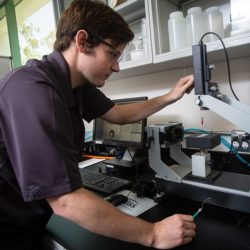
At Its Core: Far-reaching Impact of Element Autopsies
At the upcoming Membrane Technology Forum on June 14 -16, 2022, Scott LaRoche, Director of Applications Engineering at Solecta, will share his insights on what can be learned from conducting an element autopsy and performing detailed analyses.
As part of a holistic approach, element autopsies can be an effective technique to help reinforce and validate good performance in a given membrane separations application or troubleshoot issues and identify the root cause of sub-optimal performance within a membrane/or element itself.
One of the ways clients most value autopsies is in helping to troubleshoot and resolve operational challenges related to their complex separation processes. “As part of our comprehensive approach to improve the overall operation of our client’s systems, we utilize diagnostic element autopsies as a proven method to uncover and resolve underlying issues,” says LaRoche. “Element autopsies can be performed to identify root causes of client issues and may include determining if there is a membrane issue, an element operational concern or a fouling/scaling problem due to ineffective cleaning that is impacting how the element runs in a client’s system. The element autopsy provides us with the scientific clues to determine what is happening within a client’s process.”
Element autopsies can also be performed as part of an “end-of-life” investigation on elements.
“We use these end-of-life opportunities to examine the degradation over time, evaluate how the element performed over its life and take back what we learned to the Solecta team for continuous improvement.”
Steps Being Taken
Solecta has developed a standard protocol for autopsying elements, and depending on the nature of the problem, additional steps may be performed. The autopsy generally begins with a visual and physical inspection of the element to identify changes in appearance or obvious structural changes. Are there any dents or crushing of the element? Is there migration of the outer wrap? Telescoping or feed spacer extrusion?
“The visual inspection helps identify anything that looks questionable,” LaRoche says, “as this can help to determine manufacturing or operational issues. Then we do an element integrity evaluation to see if the element is leaking.”
Following the non-destructive visual and integrity inspections, the physical autopsy takes place. This destructive step involves cutting the element open to examine the internal components.
As LaRoche explains, once opened, the internal layers and construction of the element can be examined. The membrane surface will be evaluated for any soil buildup, including the appearance of the soil, the location and how consistently it is located throughout the element. In addition, the element will be examined to determine the presence, location, and prevalence of any leakage issues.
In many cases, the element will be sent to Solecta’s labs, where detailed diagnostic tests are done. If soil or other foulants are present, samples of the materials are taken and undergo in-depth analytical testing that cannot be done in the field to determine specific root causes. “Knowing that soil is present is only the first part of the investigation,” says David Kimber, Senior R&D Engineer at Solecta. “By identifying the composition of the soil, Solecta can collaborate with its clients to understand why those solids are present and work with the cleaning chemical companies to remove and prevent that soil from building up again.”
With the most successful element autopsies, it is crucial to understand the exact “symptom” the client is experiencing, when the problem started and how the system operates. These additional details help guide what testing is conducted during the autopsy to determine the true root cause, not just the point or type of failure.
Autopsies in Action
Recently, a client reported high protein passage and reached out to Solecta for help. Follow-up information provided by the client showed the issue occurred suddenly and was happening across multiple housings and stages. These additional details made several potential causes unlikely. The autopsy and subsequent analysis revealed that end seam wrinkles were observed in the membrane and were causing the high protein passage. The location of wrinkles indicated there was an opportunity to improve the operation of the client’s system to eliminate this issue and resolve the high protein leakage they were experiencing. Solecta worked closely with the client to eliminate the specific operating conditions to prevent these wrinkles from occurring and eliminated their protein leakage, which improved the protein yield by >$10,000 per day.
If you want more information about element autopsies, contact the Solecta team at [email protected].
Information about the upcoming presentation at the Membrane Technology Forum can be found here.
Related Resources in the Knowledge Hub
Let’s Keep in Touch
Follow Solecta on LinkedIn and join our mailing list to keep up with our latest news.
Explore the Possibilities
Our team of application engineers and domain experts understands your industry’s unique challenges. (They’re also eager to solve them.)








